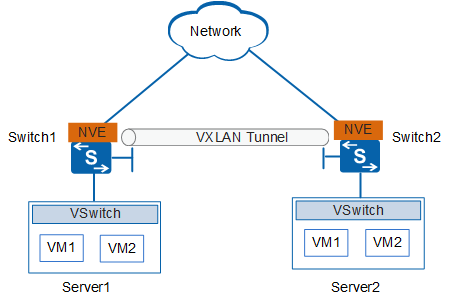VXLAN QoS
VXLAN quality of service (QoS) provides differentiated service in VXLAN applications. A device implements mapping between QoS priorities in original packets, internal priorities (local precedence assigned by the device to differentiate service classes of packets), and priorities of encapsulated packets. In this way, the switch provides the differentiated QoS service based on original packets.
On the network as shown in Figure 1, VXLAN QoS implements mapping between QoS priorities in original packets, internal priorities, and priorities of encapsulated packets according to the following process:
An original packet arrives at a Layer 2 sub-interface on Switch1. Switch1 maps the 802.1p priority of the original packet to the internal priority (PHB and color) based on the DiffServ profile bound to the main interface, and then sends the packet to the specified queue.
After the packet enters the VXLAN tunnel, the VTEP encapsulates the packet and maps the packet's internal priority to the 802.1p priority or DSCP priority based on the default profile in the DiffServ domain. The packet is then transmitted over the VXLAN tunnel based on the 802.1p priority or DSCP priority.
When the packet leaves the tunnel, its 802.1p priority or DSCP priority (depending on which priority is trusted on the tunnel interface) is mapped to the internal priority based on the default profile in the DiffServ domain. The packet then enters the queue matching the internal priority. An Ethernet interface working in Layer 3 mode trusts the DSCP priority only.
Finally, the internal priority is mapped to the 802.1p priority based on the profile in the DiffServ domain bound to the main interface. The packet is transmitted through the outbound interface based on the 802.1p priority.
When the S6720S-EI or S6720-EI is used as the access device, it cannot map the DSCP priority of original packets in the outbound direction but can normally map the packet priority in the inbound direction. Table 1 lists other mapping rules.
Access Mode to the VXLAN Network |
Mapping Rule |
|---|---|
| By VLAN |
|
| By the flow encapsulation type default |
|
| By the flow encapsulation type untag |
|
| By the flow encapsulation type dot1q |
|
| By the flow encapsulation type qinq |
|
For details, see Configuring Priority Mapping in "Priority Mapping Configuration" in the S2720, S5700, and S6700 V200R019C10 Configuration Guide - QoS.
